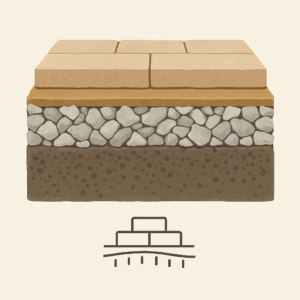Building Solid Ground: Key Principles for Choosing the Best Base for Any Hardscape Project
Key Takeaways
- Selecting the proper base is crucial for long-lasting hardscape installations.
- Different materials offer varied benefits depending on the project.
- Knowledge of foundational principles can prevent future structural issues.

A building is only as strong as its foundation, and this mantra holds more than ever in hardscaping. The foundation is the foundation upon which creativity meets function, serving as the firm understructure supporting the intended design. Without it, even the most beautifully designed projects can succumb to the stresses of time and nature. The foundation manages moisture, bears weight, and locks in the structural integrity needed for a long-lasting build.
Selecting the appropriate foundation is a pivotal aspect of any hardscape endeavor. The art and science of laying a proper base ensure that patios, pathways, and retaining walls retain their intended form and function over time. Utilizing a reliable combination of hardscape materials is critical to prevent common structural issues such as cracking and shifting. Although often overlooked, the importance of a robust base is monumental for the longevity and stability of any construction project.
With many materials, understanding each option’s advantages and drawbacks is essential. Climate, soil composition, and load-bearing requirements influence these decisions. Every material, from crushed stone to sand, offers unique benefits tailored to specific needs, guiding builders to the most appropriate selection for their hardscape aspirations.
Understanding Base Material Options
The vast array of materials available for hardscape bases can be both a blessing and a challenge. The strengths of materials like crushed stone, sand, and gravel are each essential in a project. Crushed stone provides excellent drainage and stability, making it ideal for areas with heavy rainfall. Sand offers flexibility, accommodating shifting soils and allowing ease of installation for curved designs. Knowing each material’s properties enables us to pinpoint its optimal use based on distinct project needs, whether durability, aesthetics, or economy.
Factors Influencing Base Material Choice
The base material is critical in hardscape design and construction, affecting durability, stability, and drainage. Factors like soil type, climate, and intended use determine the optimal material selection. For example, crushed stone or gravel provides excellent drainage for patios and walkways, while compacted sand works well for pavers. A permeable base can prevent water buildup and erosion in areas with heavy rainfall. Load-bearing capacity is also essential for driveways and retaining walls. Choosing the right base ensures a long-lasting, structurally sound hardscape that enhances function and aesthetics.
Benefits of a Well-Constructed Base
Investing time and resources in creating a well-designed base can significantly increase the lifespan of a hardscape installation. A correctly constructed foundation supports weight from above, distributes pressure evenly, and prevents the dreaded issues of sinking and shifting. Over time, this reduces the need for maintenance, preserving the project’s aesthetic appeal and functionality. Moreover, it ensures safety, as even minor foundational failures can lead to accidents or structural damage.
Expert Tips for Base Installation
Gathering insights from experienced builders can tremendously elevate your approach to base installation. Recommended strategies include layering materials according to best practices, utilizing geotextiles for additional stabilization, and regularly testing soil conditions. A properly layered base fortifies the construction above and incorporates elements that adapt to environmental changes, ensuring longevity. Learning from those who have tackled similar challenges equips builders with practical tactics that translate into efficient and robust installations.
Conclusion
Ultimately, the foundation sets the precursor for every successful hardscape project. The outcome is visually stunning and functionally sound by allocating due diligence in planning and choosing the right materials tailored to environmental and structural demands. A well-chosen and meticulously installed base upholds the structure above and enhances the project’s overall value. Understanding and applying these key principles ensures that your hardscape project stands the test of time, remaining a testament to quality and foresight.

